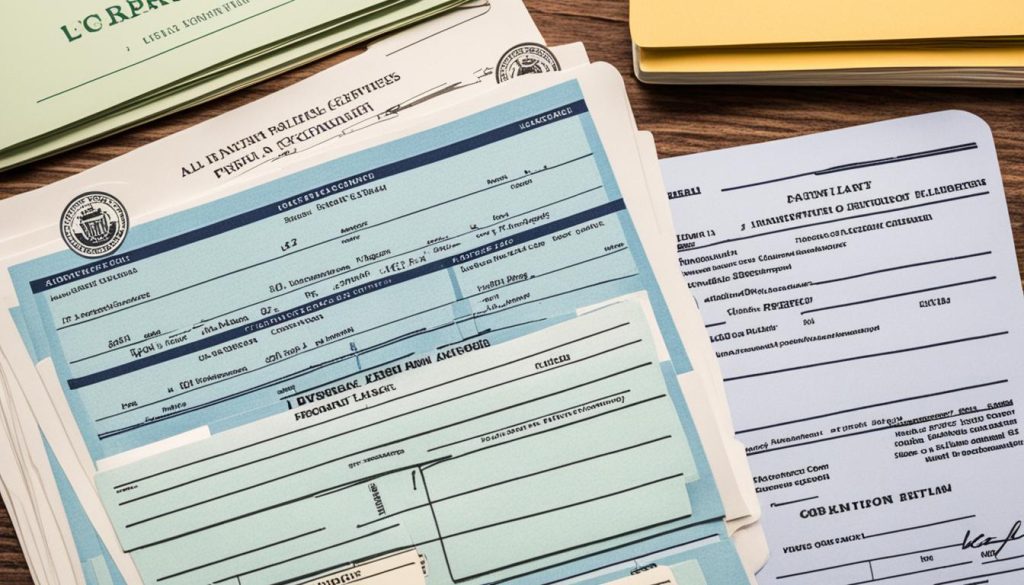Are you considering changing your legal name in Canada? Perhaps you recently got married or divorced, or maybe you simply want to adopt a new name that better represents your true identity. Whatever the reason may be, navigating the process of a legal name change can seem daunting. That’s why we’ve put together this step-by-step guide to help make the process a little bit easier for you. From understanding the requirements for a legal name change to completing the necessary forms and paying the fees, we’ll walk you through the entire process. So, if you’re ready to embark on this transformative journey, read on to learn how to change your legal name in Canada.
Introduction to Changing Legal Name in Canada
Canadians may legally change their name for personal or professional reasons. The legal name change process varies by province, but generally involves submitting an application, providing supporting documents, undergoing a criminal record check, and paying government and service fees. The process can take several weeks to complete. Legal name changes are recorded in government records and require updating identification documents like birth certificates, driver’s licences, and canadian passports.
Eligibility Criteria for Legal Name Change
Canadians seeking to legally change their name must meet specific eligibility criteria, which can vary by province. In Ontario, the key requirements include residency and age-based guidelines.
1. Residency Requirements
To be eligible for a legal name change in Ontario, applicants must have resided in the province for at least 12 consecutive months prior to submitting their application.
2. Age Requirements
In Ontario, only individuals aged 16 years or older can apply for a legal name change. Those between the ages of 16 and 17 must also obtain consent from all their legal guardians before proceeding with the name change process.
3. Ineligible Applicants
Certain individuals may be ineligible to legally change their name in Ontario. This includes those who have outstanding criminal charges, are serving a sentence, or have had a previous name change application rejected within the last 12 months.
Situations Not Requiring Legal Name Change
While many Canadians may choose to legally change their name, there are several common scenarios where a formal legal name change process is not necessary. These include:
1. Name Change After Marriage
In Ontario, you do not need to legally change your name after marriage to use your spouse’s surname. You have the option to continue using your current last name, assume your spouse’s last name, or use a combination of both names.
2. Reverting to Birth Surname
If you have previously assumed your spouse’s last name, you can revert to using your birth surname without going through the legal name change procedure. This is a common occurrence after divorce or separation.
3. Changing Child’s Given Name
Parents in Ontario can change their child’s given name (first name) without a full legal name change process, as long as both legal guardians consent to the change.
Cost of Legal Name Change
Changing one’s legal name in Canada can incur various fees and expenses. The primary cost is the government application fee, which varies across provinces and territories. Additionally, there may be supplementary costs associated with obtaining updated identification documents reflecting the new name.
1. Government Fees
In Ontario, the government application fee for an adult legal name change is $137. This fee covers the administrative processing of the name change request and its registration within the provincial records.
2. Additional Costs
Beyond the government fee, individuals may need to budget for additional expenses related to updating their identification documents. This can include the cost of obtaining new birth certificates, driver’s licenses, passports, and other official records bearing the changed name. The specific fees for these services can vary depending on the province or territory and the type of document being replaced.
How to Apply for Legal Name Change?
The process of legally changing your name in Canada involves several key steps. To begin, it’s essential to thoroughly review the information guide provided by the province or territory where you reside. This guide will outline the specific requirements and documentation needed for your name change application.
1. Read Information Guide
The first step is to carefully read through the information guide to ensure you understand the eligibility criteria, residency requirements, and any other necessary details. This will help you prepare the correct documentation and complete the application form accurately.
2. Complete Application Form
Once you’ve reviewed the guide, you can proceed to fill out the name change application form. This form will typically request personal information, such as your current legal name, date of birth, and contact details. Ensure that you provide all the required information and that it matches your supporting documents.
3. Gather Supporting Documents
Along with the completed application form, you’ll need to gather a range of supporting documents. This may include your birth certificate, proof of residency, and any relevant immigration documents or marriage certificates. Carefully review the list of required documents to ensure you have everything ready to submit with your application.

Required Documents for Legal Name Change
When applying to change your name in Ontario, there are several key documents you’ll need to provide as part of the application process. These include:
Birth Certificates
Submitting your original birth certificate is a mandatory requirement for a legal name change in Ontario. If you were born outside of Canada, you’ll also need to provide a certified copy of your permanent resident card or Canadian citizenship document.
Immigration Documents
For individuals who were born outside of Canada, presenting a certified copy of your permanent resident card or Canadian citizenship document is necessary to support your name change application.
Marriage Certificates
If you’ve been married, a copy of your marriage certificate will be required as part of the name change process, as this may impact the name you’re seeking to change to.
Child’s Birth Certificate
If you’re applying to change the name of a child, you’ll need to submit the child’s birth certificate as well as provide consent from any other legal guardians.
Fingerprinting and Criminal Record Check
As part of the legal name change process in Ontario, applicants who are 18 years of age and older must undergo fingerprinting and a criminal record check. This requirement ensures the validity and integrity of the name change application.
Fingerprinting Agencies
Fingerprints can be taken at various authorized locations, such as RCMP detachments, the Toronto Police Service, or accredited private companies that provide fingerprinting services. Applicants are responsible for scheduling and completing the fingerprinting process as per the instructions provided by the provincial government.
Criminal Record Check Requirements
The criminal record check is conducted to verify that the applicant does not have any outstanding criminal charges or convictions that could potentially impact the name change request. The results of the criminal record check are reviewed by the authorities before the name change application can be approved.

How to Change Your Legal Name in Canada?
To change your legal name in Canada, you can choose between an online and offline application process. The method you select will depend on your specific circumstances and the province or territory where you reside.
1. Online Application Process
The online application option is available in some provinces, such as Ontario, and is typically restricted to adults changing their own name. This streamlined approach allows you to complete the necessary forms and submit supporting documents electronically, often reducing the overall processing time.
2. Offline Application Process
For individuals who do not have access to the online application or prefer a more traditional method, the offline application process is a viable option. This involves printing and completing the required application form, gathering the necessary documents, and submitting the package either by mail or in person at the designated government office.
Regardless of the approach you choose, it is essential to carefully review the specific requirements and documentation needed for your province or territory to ensure a smooth and successful legal name change in Canada.
Changing a Child’s Name
When it comes to legally changing a child’s name in Ontario, the process involves additional considerations and requirements. Each adult with legal custody of the child must consent to the name change, and if the child is 12 years of age or older, they must also provide their consent.
1. Consent Requirements
In Ontario, every person who has legal custody of a child must give their consent for the child’s name to be changed. This includes both parents, guardians, or any other individuals with legal decision-making authority over the child.
2. Child’s Consent for Name Change
If the child is 12 years of age or older, they must also provide their consent for the name change. This ensures that the child’s preferences are taken into account and respects their autonomy in this process.

Reclaiming Indigenous Names
In recognition of the historical injustices faced by Indigenous communities in Canada, the legal name change process has been amended to better support the reclamation of traditional names. Ontario, in particular, offers a significant fee waiver for Survivors of residential schools and their family members who wish to reclaim their ancestral names.
Eligibility for Indigenous Name Reclamation
The fee waiver for Indigenous name reclamation is available to those who can demonstrate their connection to the residential school system, either as a Survivor or as a direct family member. This includes individuals who had their traditional names replaced with colonial names during the residential school era.
Process for Indigenous Name Reclamation
The process for reclaiming an Indigenous name in Ontario involves submitting an application, providing supporting documentation, and undergoing a criminal record check, similar to the standard legal name change process. However, the application fee is waived for eligible applicants, making the process more accessible. Individuals are also able to change to a single name, if that is the culturally appropriate format for their Indigenous identity.
By facilitating the reclamation of traditional names, the Ontario government aims to acknowledge the cultural significance of these identities and support the ongoing reconciliation efforts with Indigenous communities across the province.
After Legal Name Change
Once your legal name change application in Ontario has been approved, you’ll receive a Change of Name Certificate showcasing your previous and new names. This official document serves as proof of your legally recognized name change.
Name Change Certificates
The Change of Name Certificate issued by the Office of the Registrar General is an essential document that you’ll need to update your various government-issued identification cards and records. This certificate formally acknowledges your new legal name and can be used to request updated birth certificates, driver’s licenses, passports, and other ID.
Updated Birth Certificates
In addition to the Change of Name Certificate, you’re also entitled to obtain a new birth certificate reflecting your updated legal name. This revised birth certificate will not contain any parental information, ensuring your privacy. You can apply for the updated birth certificate through the Office of the Registrar General.
Marriage Record Amendment
If you’re married, you’ll also need to amend your marriage record to reflect your new legal name. This can be done by submitting a completed Application for Amendment of Marriage Record form to the Office of the Registrar General, along with your Change of Name Certificate and marriage certificate.

Conclusion
Legally changing one’s name in Canada is a multi-step process that varies across the provinces, but generally involves submitting an application, providing supporting documents, undergoing a criminal record check, and paying government and service fees. Applicants must typically meet residency and age criteria, with some exceptions like name changes after marriage not requiring a full legal name change.
Indigenous Canadians have the option to reclaim their traditional names through a separate application process with waived fees. Overall, the legal name change procedure can take several weeks to complete and requires updating a person’s official identification records accordingly.
By understanding the specific requirements and steps involved, Canadians can successfully navigate the legal name change process and update their personal identities as needed, whether for personal, professional, or cultural reasons.
FAQ
1. What are the requirements to legally change your name in Canada?
To change your name as an adult in Ontario, you must be 16 years of age or older and have lived in Ontario for the past 12 months. If you are 16 or 17 years old, you will need consent from every person who has legal custody of you before you can change your name.
2. Do I need to legally change my name after getting married in Canada?
No, you do not need to legally change your name after marriage to use your spouse’s surname in Canada. You can continue using your current last name, assume your spouse’s last name, or use a combination of both.
3. How much does it cost to legally change your name in Canada?
The government application fee for an adult legal name change in Ontario is $137. There may be additional costs for obtaining new identity documents with the changed name.
4. What documents do I need to change my legal name in Canada?
To change your name in Ontario, you need to provide your original birth certificate. If you were born outside Canada, you need to provide a certified copy of your permanent resident card or Canadian citizenship document. Marriage certificates are also required if applicable.
5. Do I need to undergo a criminal record check for a legal name change in Canada?
Yes, Ontario applicants 18 years and older must undergo fingerprinting and a criminal record check as part of the legal name change process. Fingerprints can be taken at RCMP detachments, the Toronto Police Service, or accredited private companies.
6. How do I apply for a legal name change in Canada?
In Ontario, you need to download the appropriate application form, complete it, and submit it along with required documents and payment either by mail or in person. The process involves providing proof of identity, residency, and consent if applicable.
7. Can I change my child’s name legally in Canada?
Yes, in Ontario, each adult with legal custody of a child must consent to changing the child’s name. If the child is 12 years of age or older, they must also consent to the name change.
8. How can Indigenous Canadians reclaim their traditional names?
Ontario offers a fee waiver for Survivors of residential schools and their family members who are reclaiming their traditional Indigenous names. They can change to a single name if it is part of their culture.




